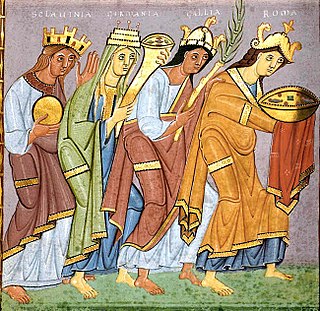
The Curta is a hand-held mechanical calculator designed by Curt Herzstark. It is known for its extremely compact design: a small cylinder that fits in the palm of the hand. It was affectionately known as the "pepper grinder" or "peppermill" due to its shape and means of operation; its superficial resemblance to a certain type of hand grenade also earned it the nickname "math grenade".

Samo founded the first recorded political union of Slavic tribes, known as Samo's Empire, ruling from 623 until his death in 658. According to Fredegarius, the only contemporary source, Samo was a Frankish merchant who unified several Slavic tribes against robber raids and violence by nearby settled Avars, showing such bravery and command skills in battle that he was elected "King of the Slavs". In 631, Samo successfully defended his realm against the Frankish Kingdom in the three-day Battle of Wogastisburg.

The West Slavs are Slavic peoples who speak the West Slavic languages. They separated from the common Slavic group around the 7th century, and established independent polities in Central Europe by the 8th to 9th centuries. The West Slavic languages diversified into their historically attested forms over the 10th to 14th centuries.
The Early Middle Ages in Romania started with the withdrawal of the Roman troops and administration from Dacia province in the 270s. In the next millennium a series of peoples, most of whom only controlled two or three of the nearly ten historical regions that now form Romania, arrived. During this period, society and culture underwent fundamental changes. Town life came to an end in Dacia with the Roman withdrawal, and in Scythia Minor – the other Roman province in the territory of present-day Romania – 400 years later. Fine vessels made on fast potter's wheels disappeared and hand-made pottery became dominant from the 450s. Burial rites changed more than once from cremation to inhumation and vice versa until inhumation became dominant by the end of the 10th century.

The Sclaveni or Sklabenoi were early Slavic tribes that raided, invaded and settled in the Balkans in the Early Middle Ages and eventually became one of the progenitors of modern South Slavs. They were mentioned by early Byzantine chroniclers as barbarians having appeared at the Byzantine borders along with the Antes, another Slavic group. The Sclaveni were differentiated from the Antes and Wends ; however, they were described as kin. Eventually, most South Slavic tribes accepted Byzantine or Frankish suzerainty, and came under their cultural influences and Chalcedonian Christianity. The term was widely used as a general catch-all term until the emergence of separate tribal names by the 10th century.

Regina Maria Loureiro Barreto CaséOMC is a Brazilian actress, screenwriter, director, producer, and television presenter.

Dardania was a Roman province in the Central Balkans, initially an unofficial region in Moesia (87–284), and then a province administratively part of the Diocese of Moesia (293–337). It was named after the tribe of the Dardani who inhabited the region in classical antiquity prior to the Roman conquest.

The Antes or Antae were an early Slavic tribal polity of the 6th century CE. They lived on the lower Danube River, in the northwestern Black Sea region, and in the regions around the Don River. Scholars commonly associate the Antes with the archaeological Penkovka culture.
Florin Curta is a Romanian-born American archaeologist and historian who is a professor of medieval history and archaeology at the University of Florida.
Zicídeva was an Early Byzantine town, tentatively identified with the late antique settlement excavated on the top of Tsarevets hill, near modern Veliko Tarnovo in northern Bulgaria.

Hemilophini is a tribe of longhorn beetles of the subfamily Lamiinae.
Alampyris is a genus of longhorn beetles of the subfamily Lamiinae, containing the following species:
Alampyris fuliginea is a species of beetle in the family Cerambycidae. It was described by Henry Walter Bates in 1881. It is known from Mexico.
Alampyris marginella is a species of beetle in the family Cerambycidae. It was described by Henry Walter Bates in 1881. It is known from Mexico.
Alampyris nigra is a species of beetle in the family Cerambycidae. It was described by Henry Walter Bates in 1881. It is known from Mexico.
Alampyris cretaria is a species of beetle in the family Cerambycidae. It was described by Henry Walter Bates in 1885. It is known from Mexico.
Alampyris flavicollis is a species of beetle in the family Cerambycidae. It was described by Galileo and Martins in 2005. It is known from Costa Rica.
Alampyris fusca is a species of beetle in the family Cerambycidae. It was described by Martins and Galileo in 2008. It is known from Costa Rica.
Alampyris melanophiloides is a species of beetle in the family Cerambycidae. It was described by Thomson in 1868. It is known from Mexico.
The history of Christianity in Hungary started in the Roman province of Pannonia, centuries before the arrival of the Magyars, or Hungarians.







